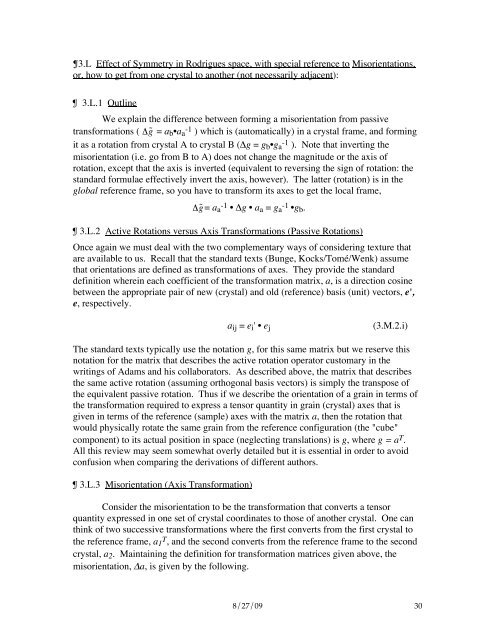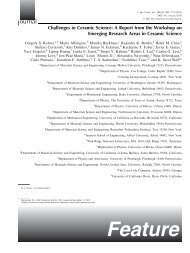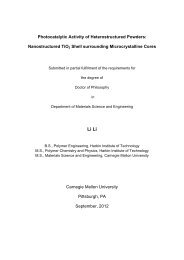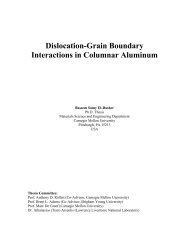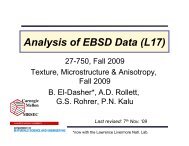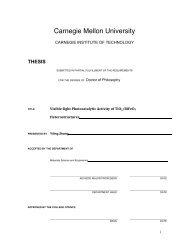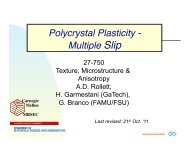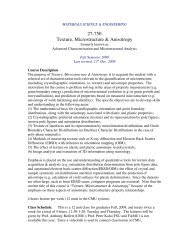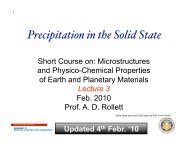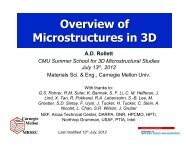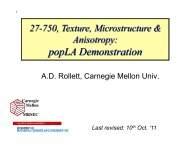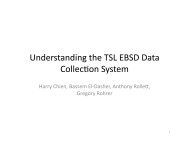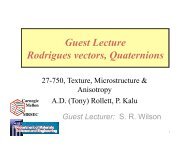¶ 3. Mathematical Representation of Crystal Orientation, Misorientation
¶ 3. Mathematical Representation of Crystal Orientation, Misorientation
¶ 3. Mathematical Representation of Crystal Orientation, Misorientation
Create successful ePaper yourself
Turn your PDF publications into a flip-book with our unique Google optimized e-Paper software.
<strong>3.</strong>L Effect <strong>of</strong> Symmetry in Rodrigues space, with special reference to <strong>Misorientation</strong>s,<br />
or, how to get from one crystal to another (not necessarily adjacent):<br />
<strong>3.</strong>L.1 Outline<br />
We explain the difference between forming a misorientation from passive<br />
transformations ( = ab•aa -1 ) which is (automatically) in a crystal frame, and forming<br />
it as a rotation from crystal A to crystal B (∆g = gb•ga -1 ! g ˜<br />
). Note that inverting the<br />
misorientation (i.e. go from B to A) does not change the magnitude or the axis <strong>of</strong><br />
rotation, except that the axis is inverted (equivalent to reversing the sign <strong>of</strong> rotation: the<br />
standard formulae effectively invert the axis, however). The latter (rotation) is in the<br />
global reference frame, so you have to transform its axes to get the local frame,<br />
! g<br />
˜<br />
= aa -1 • ∆g • aa = ga -1 •gb.<br />
<strong>3.</strong>L.2 Active Rotations versus Axis Transformations (Passive Rotations)<br />
Once again we must deal with the two complementary ways <strong>of</strong> considering texture that<br />
are available to us. Recall that the standard texts (Bunge, Kocks/Tomé/Wenk) assume<br />
that orientations are defined as transformations <strong>of</strong> axes. They provide the standard<br />
definition wherein each coefficient <strong>of</strong> the transformation matrix, a, is a direction cosine<br />
between the appropriate pair <strong>of</strong> new (crystal) and old (reference) basis (unit) vectors, e',<br />
e, respectively.<br />
aij = ei' • ej (<strong>3.</strong>M.2.i)<br />
The standard texts typically use the notation g, for this same matrix but we reserve this<br />
notation for the matrix that describes the active rotation operator customary in the<br />
writings <strong>of</strong> Adams and his collaborators. As described above, the matrix that describes<br />
the same active rotation (assuming orthogonal basis vectors) is simply the transpose <strong>of</strong><br />
the equivalent passive rotation. Thus if we describe the orientation <strong>of</strong> a grain in terms <strong>of</strong><br />
the transformation required to express a tensor quantity in grain (crystal) axes that is<br />
given in terms <strong>of</strong> the reference (sample) axes with the matrix a, then the rotation that<br />
would physically rotate the same grain from the reference configuration (the "cube"<br />
component) to its actual position in space (neglecting translations) is g, where g = a T .<br />
All this review may seem somewhat overly detailed but it is essential in order to avoid<br />
confusion when comparing the derivations <strong>of</strong> different authors.<br />
<strong>3.</strong>L.3 <strong>Misorientation</strong> (Axis Transformation)<br />
Consider the misorientation to be the transformation that converts a tensor<br />
quantity expressed in one set <strong>of</strong> crystal coordinates to those <strong>of</strong> another crystal. One can<br />
think <strong>of</strong> two successive transformations where the first converts from the first crystal to<br />
the reference frame, a1 T , and the second converts from the reference frame to the second<br />
crystal, a2. Maintaining the definition for transformation matrices given above, the<br />
misorientation, ∆a, is given by the following.<br />
8/27/09 30


